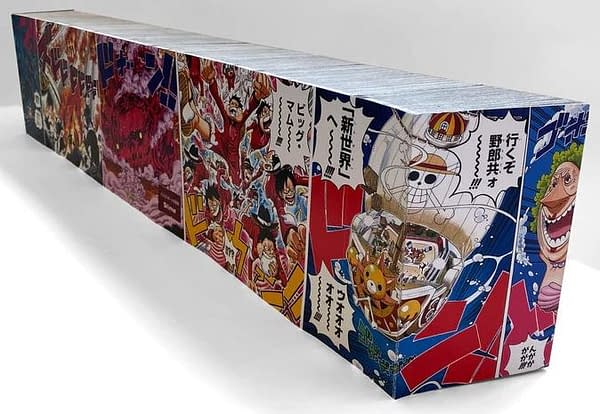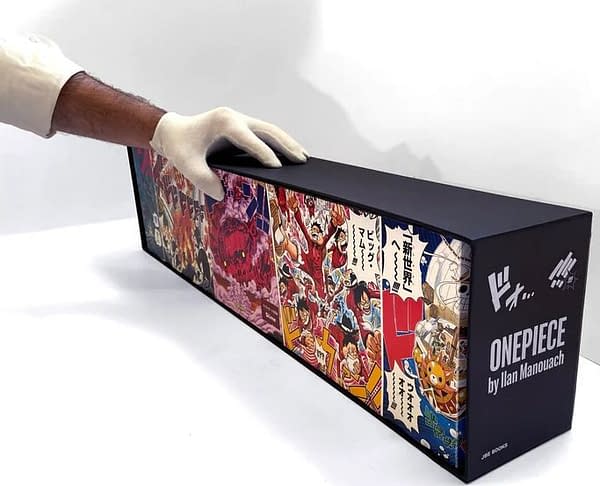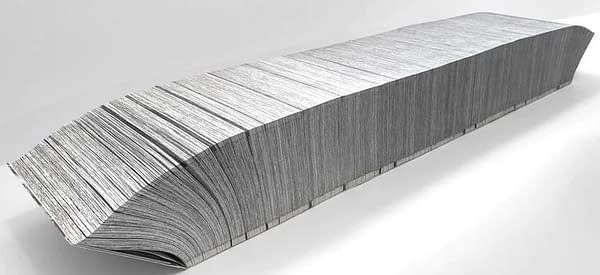|
JBE Books has revealed fifty editions of what it calls the most important e book on the earth, one quantity containing each subject of the manga One Piece. In, you recognize, one piece. Called ONEPIECE and credited to artist Ilan Manouach moderately than the comedian e book creator Eiichiro Oda, the entire editions are numbered and signed by Manouach as if it have been a a very separate piece of artwork to the comedian e book. Which, provided that it’s too huge to really learn, might sound justified to some.

In whole it’s 21,450 lengthy. In comparability that’s 4 full Cerebus or Savage Dragons. Its pages are 12cm x 18.5cm x 80 cm, it’s 16.5kg in weight and have been offered (it’s now offered out) for $1900 every, plus transport.

One Piece by Eiichiro Oda and his studio has been serialized in Shueisha’s Weekly Shōnen Jump manga journal since July 1997 and lasted 23 consecutive years, serialized in 102 volumes, with the Guinness World Records for essentially the most copies revealed for a similar comedian e book collection by a single writer, with over 516.5 million copies in circulation throughout 61 nations and areas worldwide.

Digital comics are on the pulsating middle of a worldwide, leisure business. Online participatory tradition and the medium’s new networked potentialities have intensified the character of comics past the scope {of professional}, established experience with new and disruptive types of entrepreneurial fan tradition. Readers scan, translate and distribute on-line their favourite manga collection. ONEPIECE is a product of this expanded digital manufacturing belt.

The profusion of accessible on-line content material and the rampant digitization of the comics business, challenges the state-of-the-art of comics craftsmanship. Ilan Manouach’s ONEPIECE proposes to shift the understanding of digital comics from a qualitative examination of the formal potentialities of digital comics to a quantitative reappraisal of “comics as Big Data”. ONEPIECE initiates a “computational turn” in comics contributing to the formation of latest areas of follow, increasing the ever-growing inventive toolbox permitting artists to assume comics in numerous scales and temporalities.

Comics are twin objects. They have a use worth–for readers– and an alternate worth for collectors. Although these two capabilities should not working alongside a clear-cut divide, they generally run reverse to one another. ONEPIECE intensifies this duality as it may well solely be contemplated as a cloth instantiation of digital comics’ very personal media-saturated digital ecosystem. ONEPIECE exists solely as an object of pure hypothesis.

ONEPIECE by Ilan Manouach used a Japanese digital version from the web archiving ecosystem of the manga as sculptural materials. He has additionally created Tintin Akei Kongo, a translated model of the controversial Tintin In The Congo in lingala, an official Congolese language. He compiled Peanuts minus Schulz: Distributed Labor as a Compositional Practice, a conceptual comedian which brings collectively a number of comedian strips home-brewed by over one thousand deskilled microworkers from twenty completely different nations commissioned by digital labor companies. He created Katz, an actual copy of the French version of Maus, with the distinction that the mouse characters had been redrawn as cats. Yes, that is what I assumed. He can be the director of Futures of Comics, a world analysis program that “explores how comics are undergoing historic mutations in the midst of increasingly financialized, globalized technological affordances” and works at what is known as a pirate/librarian for the Conceptual Comics Collections at Ubuweb and Monoskop, is an appointed skilled in experimental comics for the Belgian authorities for its nationwide public funding program (CCAP)








Discussion about this post